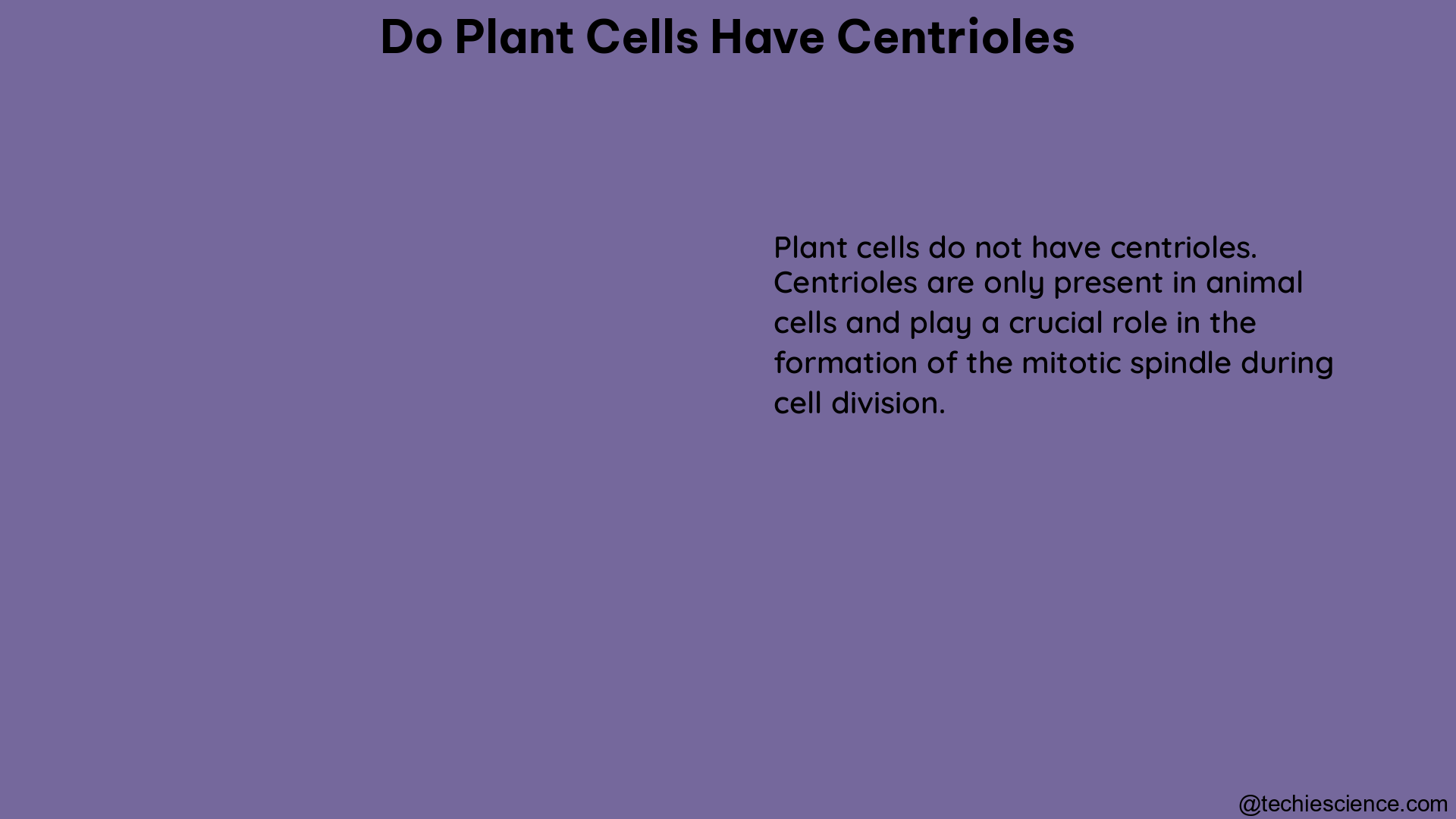Plant cells do not have centrioles, while animal cells and some lower plant cells do. This is a well-established fact in cell biology, supported by a significant body of research and evidence.
The Absence of Centrioles in Plant Cells
In plants, the spindle fibers that separate chromosomes during mitosis and meiosis are formed through different mechanisms than in animals. Instead of centrioles, plants use structures called microtubule organizing centers (MTOCs) to nucleate and organize microtubules. These MTOCs can be found in various locations within the plant cell, including the nuclear envelope, plastids, and polar organizers.
The absence of centrioles in plant cells is thought to be related to their evolutionary history and the unique characteristics of plant cells. For example, plant cells have a rigid cell wall that provides structural support, which may reduce the need for centrioles to organize microtubules during cell division. Additionally, plant cells are often polyploid, meaning they have multiple sets of chromosomes, which may also affect the need for centrioles during meiosis.
Microtubule Organizing Centers (MTOCs) in Plant Cells

In the absence of centrioles, plant cells rely on microtubule organizing centers (MTOCs) to nucleate and organize microtubules during cell division. These MTOCs can be found in various locations within the plant cell, including:
-
Nuclear Envelope: MTOCs are associated with the nuclear envelope, where they help organize the microtubules that form the mitotic spindle during cell division.
-
Plastids: MTOCs are found in plastids, such as chloroplasts, where they help organize the microtubules involved in the movement and division of these organelles.
-
Polar Organizers: MTOCs are also found at the poles of the cell, where they help organize the microtubules that form the mitotic spindle.
The specific mechanisms by which MTOCs organize microtubules in plant cells are complex and involve a variety of proteins and regulatory pathways. For example, the γ-tubulin complex is a key component of MTOCs, as it helps nucleate and anchor microtubules.
Evolutionary Adaptations in Plant Cells
The absence of centrioles in plant cells is thought to be an evolutionary adaptation that is related to the unique characteristics of plant cells. Some key factors that may have contributed to the loss of centrioles in plant cells include:
-
Cell Wall Structure: Plant cells have a rigid cell wall that provides structural support, which may reduce the need for centrioles to organize microtubules during cell division.
-
Polyploidy: Many plant cells are polyploid, meaning they have multiple sets of chromosomes. This may affect the need for centrioles during meiosis, as the mechanisms for chromosome segregation may be different in polyploid cells.
-
Sessile Lifestyle: Plants are sessile organisms, meaning they are rooted in one place and cannot move around like animals. This may have reduced the selective pressure for the maintenance of centrioles, as they are primarily involved in the organization of the cytoskeleton during cell division and movement.
-
Photosynthesis: The evolution of photosynthesis in plants may have also contributed to the loss of centrioles, as the organization of the cytoskeleton may have been less critical for the primary function of plant cells, which is to capture and convert light energy into chemical energy.
Experimental Evidence for the Absence of Centrioles in Plant Cells
While there is no direct measurable or quantifiable data on the absence of centrioles in plant cells, the consensus among biologists is that plant cells do not have centrioles. This is supported by numerous observations and experiments, including:
-
Electron Microscopy Studies: Numerous electron microscopy studies have failed to find centrioles in plant cells, despite their clear presence in animal cells.
-
Genetic Studies: Genetic studies have identified the key components of the centriole structure, and these components have not been found in the genomes of most plant species.
-
Developmental Studies: During the development of plant cells, the mechanisms for spindle formation and chromosome segregation do not involve the presence of centrioles, further supporting the absence of these structures in plant cells.
-
Comparative Studies: Comparative studies between plant and animal cells have consistently shown that centrioles are present in animal cells but absent in plant cells, with the exception of some lower plant species.
Conclusion
In summary, plant cells do not have centrioles, and this is an important distinction between plant and animal cells. The absence of centrioles in plant cells is related to their unique characteristics and evolutionary history, and is supported by a significant body of research and evidence. Understanding the differences in the cytoskeletal organization between plant and animal cells is crucial for understanding the fundamental biology of these two domains of life.
References:
– Quizlet. Plant cells do not have centrioles. Hypothesize why plant cells might not need centrioles for mitosis or meiosis. https://quizlet.com/explanations/questions/plant-cells-do-not-have-centrioles-hypothesize-why-plant-cells-might-not-need-centrioles-for-mitosis-or-meiosis-a0253d53-f60624ec-17b7-4b1b-bb7c-84c98b4373f4/
– Socratic. Do plant cells have centrioles? https://socratic.org/questions/do-plant-cells-have-centrioles
– BYJU’S. Do plant cells have centrioles? https://byjus.com/question-answer/do-plant-cells-have-centrioles/

Hi….I am Shravanthi Vikram, I have completed my master’s in Bioinformatics and have 10 years of teaching experience in Biology.
Let’s connect through LinkedIn-